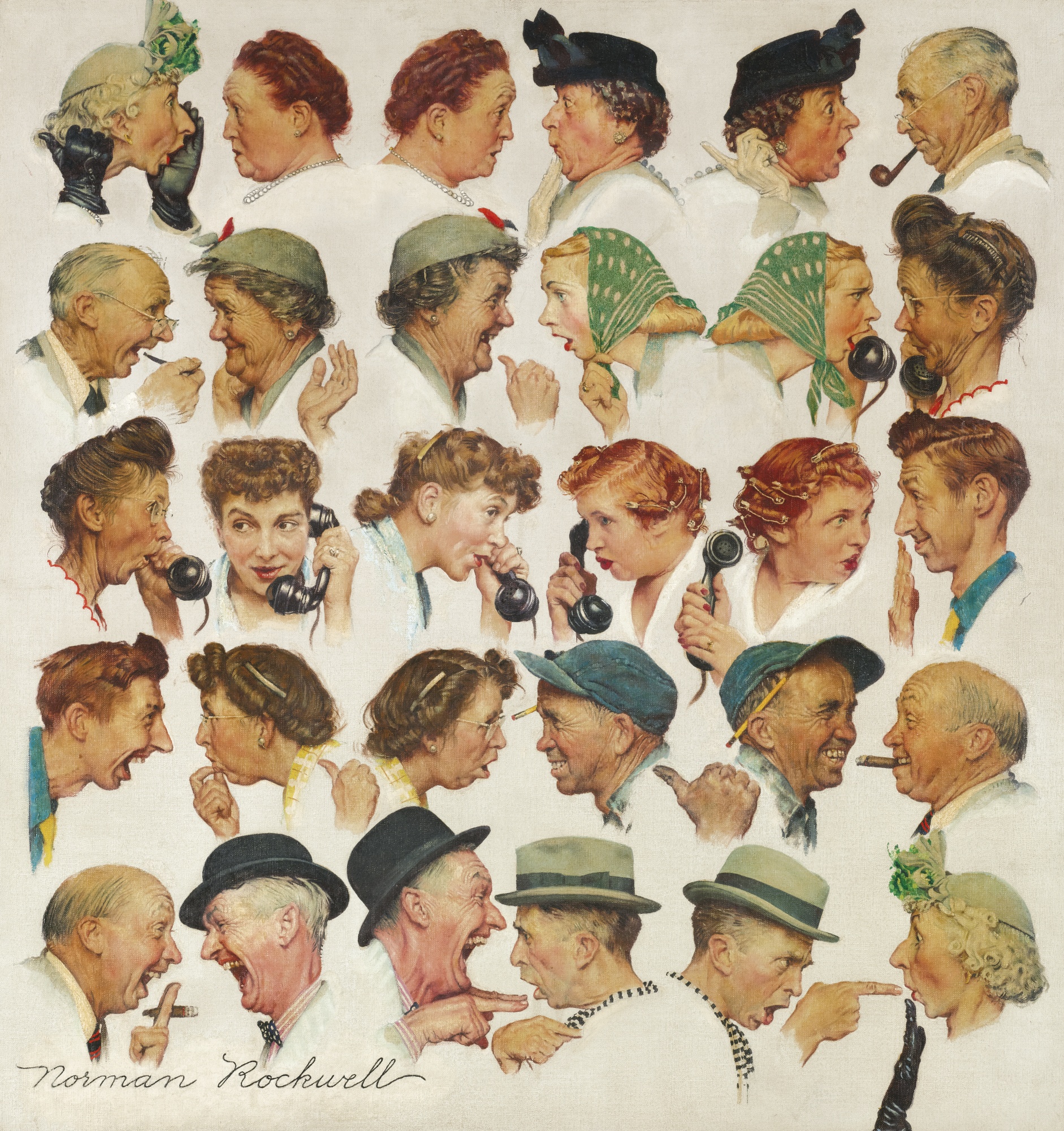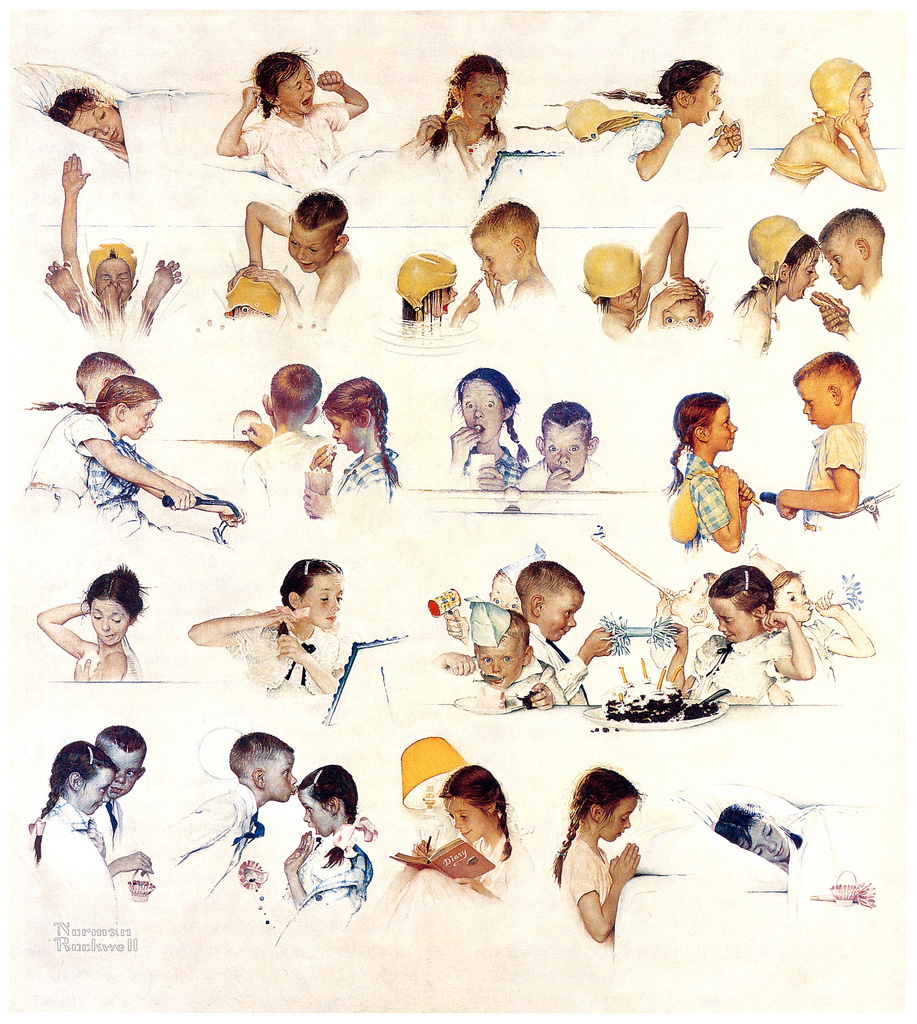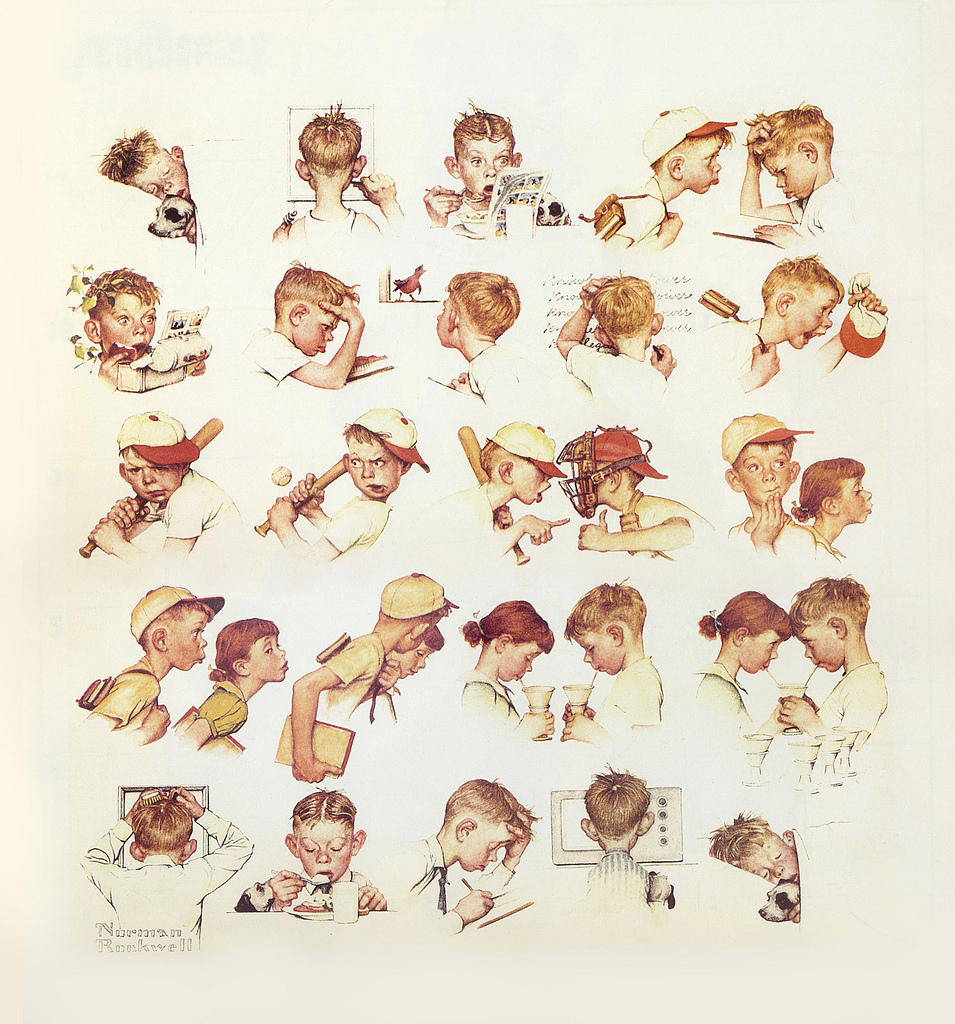Inspiration: Norman Rockwell and You
Overview:
This lesson will address Norman Rockwell’s points of inspiration including daily life in America and American culture. Students will then begin a long-term illustration project including a schematic layout, draft and final piece. Each student will consider Rockwell’s quote, “I was showing the America I knew and observed to others that might not have noticed.”
Seven or eight 60 minute class periods: Class 1- Presentation; 2 &3 - Drafting; 4-7 Work to complete illustration; 7- Critique; Optional: 8-Adjustments, Hang and video shown.
Enduring Understandings/ Essential Questions:
- Norman Rockwell was inspired by his own experiences and life around him. Generally, he was influenced by what he experienced on his vacations, nature, his neighbors and friends. He was inspired by the American culture in general, including holidays, and celebrations. Norman Rockwell was also inspired by specific groups, such as the Boy Scouts of America although he, himself, was not a member of the group.
- What inspired Norman Rockwell?
- What do you find inspirational?
- How might you be “inspired” to create an illustration representational of what you know and observe in your everyday life?
- How will you use color to emphasize a mood or emotion?
- Grade
- 5-8
- Theme
- Four Freedoms, Artistic Process
- Length
- These activities may take eight 60 minute periods.
- Discipline
- Art
- Vocabulary
- Boy Scouts of America; Critique; Culture; Cool Colors; Environment; Idioms; Inspire/Inspiration; Schematic Layout; Representational Art; Symbol; Visual Narrative; Warm Colors
Objectives:
- Students will view reproductions of Rockwell’s illustrations from various books.
- Students will consider everyday American life and cultural events as a means of inspiration (both for Rockwell and in preparation for their own piece of artwork).
- Students will look at and analyze Norman Rockwell’s painting, The Gossips, from a cultural point of view.
- Students will complete the worksheet: Story Sequence of My Life Think Sheet (5-8) in order to create a schematic layout design for their own personal sequential illustration.
- Students will demonstrate understanding of color theory regarding association with mood and emotion.
- Students will participate in a group critique and then prepare and hang their illustration for display
Background:
Norman Rockwell was surrounded by a supportive (and inspirational) community of friends and fellow artists when he lived in Arlington, Vermont from 1939 to 1953. During this time he created The Gossips which became the most popular Saturday Evening Post cover in 33 years. Norman Rockwell used his neighbors as models, but did not want to insult them so he put himself and his wife into the cover design to avoid any suspicions his friends might have. The very first version began with just two gossips, then ten and finally developed into the multiple frames you see today.
Materials:
Multimedia Resources
The Gossips
Day in the Life of a Girl
Day in the Life of a Boy
American Chronicles: The Art of Norman Rockwell
Norman Rockwell Museum
Classroom Supplies:
- American Chronicles: The Art of Norman Rockwell by Linds Szekely Pero
- Large easel with paper pad and pen
- Worksheet: Think Sheet: Story Sequence (5-8)
- Colored pencils, fine tipped pens
- Final Draft Paper
- Biography DVD: Norman Rockwell, by A&E Television Networks, 2008
Additional Teaching Resources:
The Norman Rockwell Museum at Stockbridge by The Norman Rockwell Museum
My Adventures as an Illustrator by Norman Rockwell
Norman Rockwell: Behind the Camera by Ron Schick
Norman Rockwell’s America by Christopher Finch
Norman Rockwell’s Four Freedoms: Images that Inspire a Nation by Stuart Murray, and James McCabe
Norman Rockwell’s Counting Book by Gloria Tabor
Norman Rockwell: Storyteller with a Brush, by Beverly Sherman
A Rockwell Portrait: An Intimate Biography by Donald Walton
Activities:
Class One
The students will be seated in a comfortable way so they are able to see one another and can participate in a class conversation led by the instructor. The teacher will have a marker/chalk/crayon and a board or easel to write on.
- Ask the students to listen attentively to one another as they share personal responses throughout the lesson. Ask a student to define the words inspire and inspiration. A definition will be written on the board to refer to later on in the lesson.
- An index card and a pencil will be given to each student. The students will be asked to respond to one or both of the following questions (on the index card), “What inspires you?” or “Who inspires you?” Give the students a couple of minutes to write down their ideas. Ask one or two students to share one of their ideas with the class..
- Show an image of The Gossips by Norman Rockwell and ask the students if anyone has seen this illustration before. The children will be asked to point out only what they see, not what they perceive at first. The class will collectively take a visual inventory. As each student contributes, restate their observation. You might be able to elaborate on what they have said to add more visual detail or you might ask them for clarification. You might encourage them to look more closely and carefully. By doing this, the students will analyze the work and find clues and symbols to help read the visual image, revealing American culture.
- Read an excerpt from American Chronicles: The Art of Norman Rockwell by Linda Szekely Pero explaining the what inspired Norman Rockwell and how his family and surroundings helped grant him creative ideas for his artwork (page 99-100.) Upon completion, ask the children to recall some of Rockwell’s points of inspiration and record the list on a large paper easel or board. Student participation is critical to this discussion.
- Show two other images by Rockwell and allow for time for the children to look at closely: Day in the Life of a Little Girl, Day in the Life of a Little Boy. Ask the students to explain the sequence of the images looking closely and using the clues that Rockwell provides.
Classes 2 -3
- Briefly review the list created last class about what inspired Norman Rockwell. Distribute a copy of the worksheet Think Sheet- My America Sequence 5-8 to all of the students. Read over the worksheet and explain that this is meant to help them brainstorm their ideas and create a plan for their illustration ideas. Ask the students to create a schematic layout on the back of the worksheet (first draft) based off of the following considerations: 6-8 frames must be used, color will be used to represent mood or emotion at least in one frame, clues will be given to help the viewer understand the character best. Walk around the room for informal checks of understanding and to help students. Throughout the first week working on the project, the students will be able to talk with the instructor regarding their ideas, drawings, questions and frustrations asking for help or feedback. You may ask the students to share their idea with the group, if time allows.
Classes 4-7
- During class 4, the students will pause on their individual projects to talk about idioms and color theory regarding the American culture as well as other cultures. Ask the students what they have heard being said in the American culture relating to color to a mood. Record a list of what the students offer. Ask each student to reflect on their own work and apply color to their illustration in at least one area to emphasize a mood or emotion (for example: seeing red, feeling blue.)
- Allow for three more classes for the students to complete their narrative illustrations. When most of the students have finished the project, ask the group to come together to conclude the project by presenting their illustrations to one another during a group critique to gain further feedback from their peers about their personal piece. Ask the students to present their project and explain their thoughts, particularly pointing out the one area where color has been intentionally used to emphasize a mood. Ask each student to point out what clues they have used so another may understand the setting and action. Once the artist has spoken, allow a couple of comments from classmates to be given. The comments must be given in a respectful manner, demonstrate critical thoughts and be relevant to the project. For example, a student might say, “I like the way you tinted the thumb green to emphasize she is good with gardening .”
Class 8 (Optional)
- If time permits, allow for one final class period for any adjustments to be made on the final illustration. Students that have completed the project will hang their illustration on a bulletin board in the school hallway. The instructor will play the biography DVD titled, Norman Rockwell by A&E Television Networks. All students, finished or still working will be enriched by watching and listening to the information presented in the DVD.
Assessment:
Students will be evaluated on their participation in the class discussion and in the group critique (informal checks of understanding through questions.)
- Students will be evaluated on the completion of the worksheet, including thumbnail sketches for the final, individual project regarding their own interpretation of American life as they know it. Students will be expected to revise their work before completion of their final illustration.
- Students will be evaluated with a teacher designed rubric that evaluates student understanding of assignment.
Standards
This curriculum meets the standards listed below. Look for more details on these standards please visit: ELA and Math Standards, Social Studies Standards, Visual Arts Standards.
- VA:Cn.10.1.5
- Apply formal and conceptual vocabularies of art and design to view surroundings in new ways through art-making.
- VA:Cn.10.1.6
- Generate a collection of ideas reflecting current interests and concerns that could be investigated in art-making.
- VA:Cn.10.1.7
- Individually or collaboratively create visual documentation of places and times in which people gather to make and experience art or design in the community.
- VA:Cn.10.1.8
- Make art collaboratively to reflect on and reinforce positive aspects of group identity.
- VA:Cn11.1.5
- Identify how art is used to inform or change beliefs, values, or behaviors of an individual or society.
- VA:Cn11.1.6
- Analyze how art reflects changing times, traditions, resources, and cultural uses.
- VA:Cn11.1.7
- Analyze how response to art is influenced by understanding the time and place in which it was created, the available resources, and cultural uses.
- VA:Cn11.1.8
- Distinguish different ways art is used to represent, establish, reinforce, and reflect group identity.
- VA:Cr1.1.5
- Combine ideas to generate an innovative idea for art-making.
- VA:Cr1.1.6
- Combine concepts collaboratively to generate ideas for creating art.
- VA:Cr1.1.7
- Apply methods to overcome creative blocks.
- VA:Cr1.1.8
- Document early stages of the creative process visually and/or verbally in traditional or new media.
- VA:Cr1.2.5
- Identify and demonstrate diverse methods of artistic investigation to choose an approach for beginning a work of art.
- VA:Cr1.2.6
- Formulate an artistic investigation of personally relevant content for creating art.
- VA:Cr1.2.7
- Develop criteria to guide making a work of art or design meet an identified goal.
- VA:Cr1.2.8
- Collaboratively shape an artistic investigation of an aspect of present-daylife using a contemporary practice of art and design.
- VA:Cr2.1.5
- Experiment and develop skills in multiple art-making techniques and approaches through practice.
- VA:Cr2.1.6
- Demonstrate openness in trying new ideas, materials, methods, and approaches in making works of art and design.
- VA:Cr2.1.7
- Demonstrate persistance in developing skills with various materials, methods, and approaches in creating works of art or design.
- VA:Cr2.1.8
- Demonstrate willingness to experiment, innovate, and take risks to pursue ideas, forms, and meanings that emerge in the process of art-making or designing.
- VA:Cr2.2.5
- Demonstrate quality craftmanship through care and use of materials, tools, and equipment.
- VA:Cr2.2.6
- Explain environmental implications of conservation, care, and use of art materials, tools, and equipment.
- VA:Cr2.2.7
- Demonstrate awareness of ethical responsibility to oneself and others when posting and sharing images and other materials through the internet, social media, and other communication formats.
- VA:Cr2.2.8
- Demonstrate awareness of practices, issues, and ethics of appropriation, fair use, copyright, open source, and creative commons as they apply to creating works of art and design.
- VA:Cr3.1.5
- Create artist statements using art vocabulary to describe personal choices in art-making.
- VA:Cr3.1.6
- Reflect on whether personal artwork conveys the intended meanings and revise accordingly.
- VA:Cr3.1.7
- Reflect on and explain important information about personal artwork in an artist statement or another form.
- VA:Cr3.1.8
- Apply relevant criteria to examine, reflect on, and plan revisions for a work of art or design in progress.
- VA:Pr5.1.5
- Develop a logical argument for safe and effective use of materials and techniques for preparing and presenting work.
- VA:Pr5.1.6
- Individually or collaboratively, develop a visual plan for displaying works of art, analyzing exhibit space, the needs of the viewer, and the layout of the exhibit.
- VA:Pr5.1.7
- Based on criteria, analyze methods for preparing and presenting art.
- VA:Pr5.1.8
- Collaboratively prepare and present selected theme-based artwork for display, and formulate exhibition narratives for the viewer.
- VA:Re7.2.5
- Identify and analyze cultural associations suggested by visual imagery.
- VA:Re7.2.6
- Analyze ways that visual components and cultural associations suggested by images influence ideas, emotions and actions.
- VA:Re7.2.7
- Analyze multiple ways that images influence specific audiences.
- VA:Re7.2.8
- Compare and contrast contexts and media in which viewers encounter images that influence ideasm emotions, and actions.
- VA:Re8.1.5
- Interpret art by analyzing characteristics of form and structure, contextual information, subject matter, visual elements, and use of media to identify ideas and mood conveyed.
- VA:Re8.1.6
- Interpret art by distinguishing between relevant and non-relevant contextual information and analyzing subject matter, characteristics of form and structure, and use of media to identify ideas and mood conveyed.
- VA:Re8.1.7
- Interpret art by analyzing art-making approaches, the characteristics of form and structure, relevant contextual information, subject matter, and use of media to identify ideas and mood conveyed.
- VA:Re8.1.8
- Interpret art by analyzing how the interaction of subject matter, characteristics of form and structure, use of media, art-making approaches, and relevant contextual information contributes to understanding messages or ideas and mood conveyed.
- VA:Re9.1.5
- Recognize differences in criteria used to evaluate works of art depending on styles, genres, and media as well as historical and cultural contexts.
- VA:Re9.1.6
- Develop and apply relevant criteria to evaluate a work of art.
- VA:Re9.1.7
- Compare and explain the difference between an evaluation of an artwork based on personal criteria and an evaluation of an artwork based on a set of established criteria.
- VA:Re9.1.8
- Create a convincing and logical argument to support an evaluation of art.


